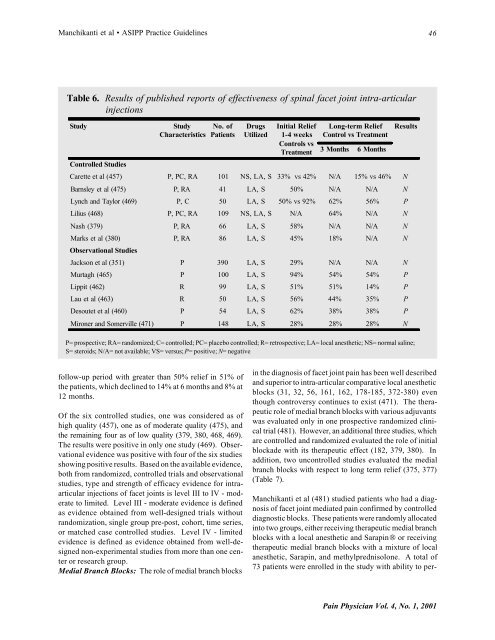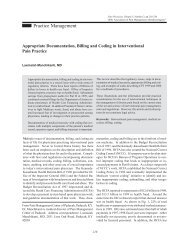ASIPP Practice Guidelines - Pain Physician
ASIPP Practice Guidelines - Pain Physician
ASIPP Practice Guidelines - Pain Physician
Create successful ePaper yourself
Turn your PDF publications into a flip-book with our unique Google optimized e-Paper software.
Manchikanti et al • <strong>ASIPP</strong> <strong>Practice</strong> <strong>Guidelines</strong><br />
46<br />
Table 6. Results of published reports of effectiveness of spinal facet joint intra-articular<br />
injections<br />
Study<br />
Controlled Studies<br />
Study<br />
Characteristics<br />
No. of<br />
Patients<br />
Drugs<br />
Utilized<br />
Initial Relief<br />
1-4 weeks<br />
Controls vs<br />
Treatment<br />
Long-term Relief<br />
Control vs Treatment<br />
3 Months 6 Months<br />
Carette et al (457) P, PC, RA 101 NS, LA, S 33% vs 42% N/A 15% vs 46% N<br />
Barnsley et al (475) P, RA 41 LA, S 50% N/A N/A N<br />
Lynch and Taylor (469) P, C 50 LA, S 50% vs 92% 62% 56% P<br />
Lilius (468) P, PC, RA 109 NS, LA, S N/A 64% N/A N<br />
Nash (379) P, RA 66 LA, S 58% N/A N/A N<br />
Marks et al (380) P, RA 86 LA, S 45% 18% N/A N<br />
Observational Studies<br />
Jackson et al (351) P 390 LA, S 29% N/A N/A N<br />
Murtagh (465) P 100 LA, S 94% 54% 54% P<br />
Lippit (462) R 99 LA, S 51% 51% 14% P<br />
Lau et al (463) R 50 LA, S 56% 44% 35% P<br />
Desoutet et al (460) P 54 LA, S 62% 38% 38% P<br />
Mironer and Somerville (471) P 148 LA, S 28% 28% 28% N<br />
Results<br />
P= prospective; RA= randomized; C= controlled; PC= placebo controlled; R= retrospective; LA= local anesthetic; NS= normal saline;<br />
S= steroids; N/A= not available; VS= versus; P= positive; N= negative<br />
follow-up period with greater than 50% relief in 51% of<br />
the patients, which declined to 14% at 6 months and 8% at<br />
12 months.<br />
Of the six controlled studies, one was considered as of<br />
high quality (457), one as of moderate quality (475), and<br />
the remaining four as of low quality (379, 380, 468, 469).<br />
The results were positive in only one study (469). Observational<br />
evidence was positive with four of the six studies<br />
showing positive results. Based on the available evidence,<br />
both from randomized, controlled trials and observational<br />
studies, type and strength of efficacy evidence for intraarticular<br />
injections of facet joints is level III to IV - moderate<br />
to limited. Level III - moderate evidence is defined<br />
as evidence obtained from well-designed trials without<br />
randomization, single group pre-post, cohort, time series,<br />
or matched case controlled studies. Level IV - limited<br />
evidence is defined as evidence obtained from well-designed<br />
non-experimental studies from more than one center<br />
or research group.<br />
Medial Branch Blocks: The role of medial branch blocks<br />
in the diagnosis of facet joint pain has been well described<br />
and superior to intra-articular comparative local anesthetic<br />
blocks (31, 32, 56, 161, 162, 178-185, 372-380) even<br />
though controversy continues to exist (471). The therapeutic<br />
role of medial branch blocks with various adjuvants<br />
was evaluated only in one prospective randomized clinical<br />
trial (481). However, an additional three studies, which<br />
are controlled and randomized evaluated the role of initial<br />
blockade with its therapeutic effect (182, 379, 380). In<br />
addition, two uncontrolled studies evaluated the medial<br />
branch blocks with respect to long term relief (375, 377)<br />
(Table 7).<br />
Manchikanti et al (481) studied patients who had a diagnosis<br />
of facet joint mediated pain confirmed by controlled<br />
diagnostic blocks. These patients were randomly allocated<br />
into two groups, either receiving therapeutic medial branch<br />
blocks with a local anesthetic and Sarapin® or receiving<br />
therapeutic medial branch blocks with a mixture of local<br />
anesthetic, Sarapin, and methylprednisolone. A total of<br />
73 patients were enrolled in the study with ability to per-<br />
<strong>Pain</strong> <strong>Physician</strong> Vol. 4, No. 1, 2001
















